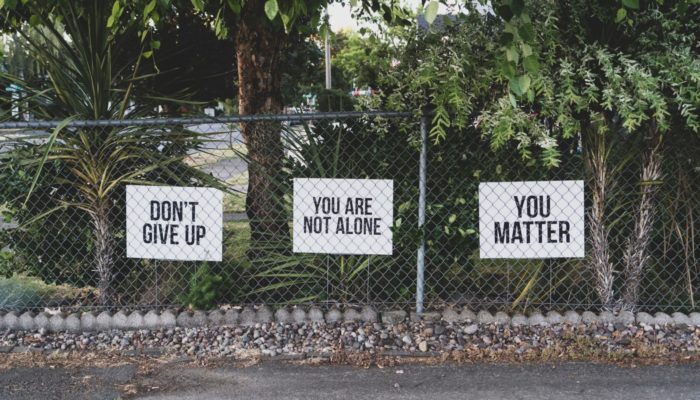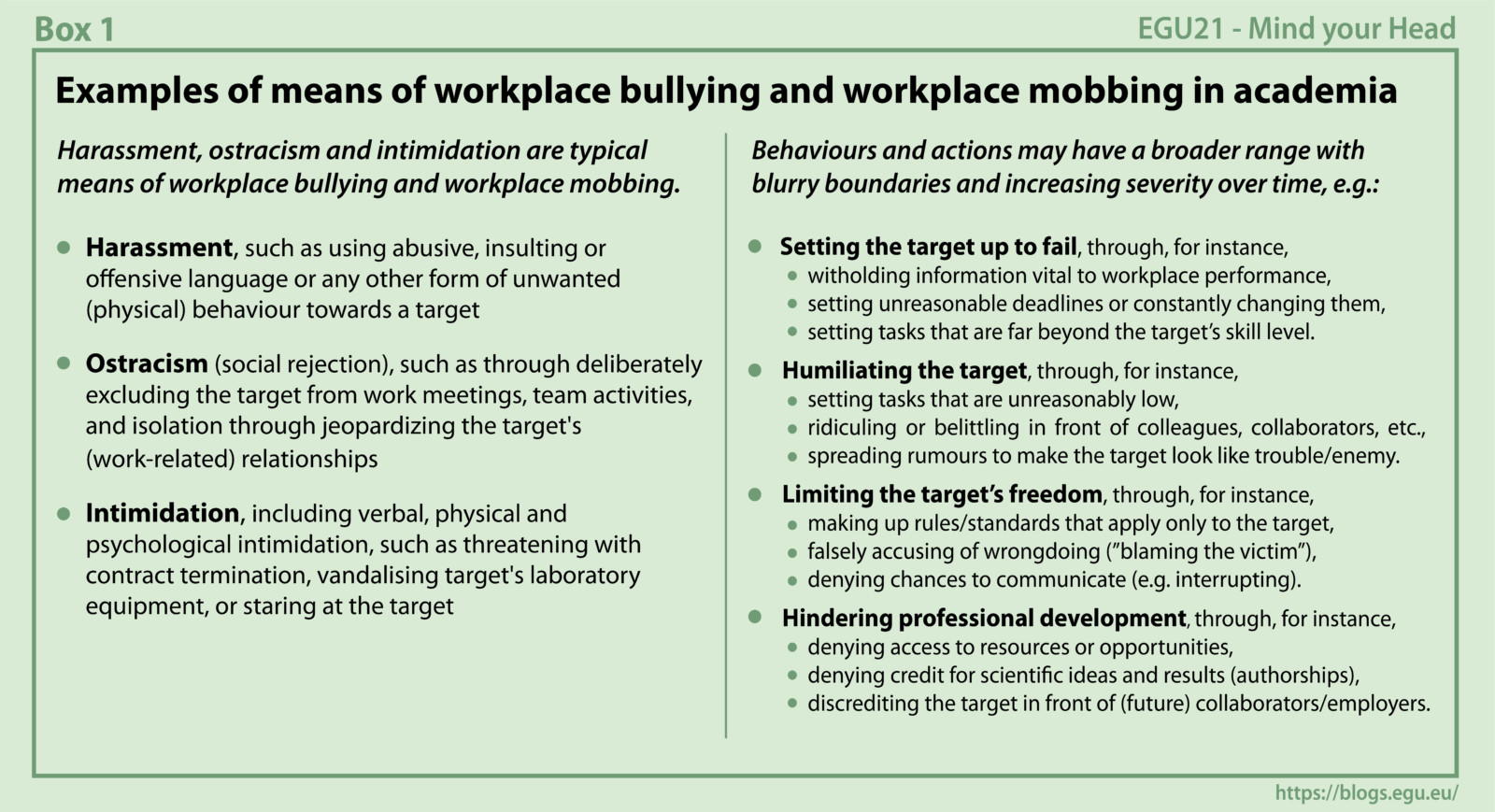
Understanding workplace aggression is a complex matter, and many questions arise when trying to tackle the issue. For instance, which acts and behaviours classify as workplace aggression, and when does something become workplace bullying or mobbing? How can you recognize if you or a co-worker/friend are the target of workplace aggression? How can you protect yourself and/or support others? What can we do to stop harmful behaviours from individuals or overarching structures? What do institutions need to do in order to create a healthy and safe work environment? These questions and more will be addressed during the upcoming EGU GA 2021 ECS Great Debate 5. This Mind your Head blog post provides a first introduction of bullying and mobbing in academia. We aim to raise awareness about the harmful effects of workplace aggression and encourage people to speak up and act. Our ultimate goal is to help create a healthy and safe work environment for everyone.
Dr. Anouk Beniest, Dr. Derya Gürer, Dr. Elenora van Rijsingen and Dr. Simone M. Pieber are early career scientists (ECS) within the European Geosciences Union (EGU). They will convene the EGU ECS Great Debate “Bullying in Academia: towards creating a healthy and safe working environment” in April 2021 during the European Geosciences Union General Assembly. Sign up here for more information.
An Introduction to Workplace Bullying in Academia
Prologue
“We were 4 days into the field expedition when I overheard my Ph.D. supervisor making disparaging remarks about someone. He was speaking in Dutch, probably assuming that I wouldn’t understand because I’m American, saying that “she”—or “zij”—was simple, physically weak, and loud. He compared zij to his “other stupid students”. I listened carefully to the crimes zij had committed, gradually becoming more and more certain that I—the only woman at the research station—was zij. This was the bully who pushed me out of research.” (Poole, Science, 2016)
Relevance
Workplace aggression, including workplace bullying and workplace mobbing, can have tremendous impacts on both the professional and the personal well-being of the target. The experience is a significant source of distress and can, for example, lead to mental health issues such as anxiety, depression, post-traumatic stress disorder, or even suicidal tendencies. The negative effects go beyond those on the target. Also bystanders may suffer, and even aggressors (bullies) themselves may be adversely affected when a situation eventually escalates. Last, but not least, the work performance of all that are involved can suffer, leading to failed projects, loss of research funding and sometimes also prematurely terminated careers. Creating healthy and safe working environments should therefore be of top priority to academic institutions, and thus also the geosciences community.
Basics
Workplace aggression has many faces. Aside from the occasional loud word, or the explicit physical violence, there are also more subtle ways, including emotional abuse and other forms of psychological manipulation, which can be at least as severe and impactful. In general, workplace aggression can be defined as singular episodes of i) verbal, ii) physical, or iii) psychological attacks. The aggression may be in response to one particular situation or associated to one particular conflict and can thus occur without the primary intent to harm a particular person. Workplace bullying and workplace mobbing on the other hand are both distinct forms of workplace aggression that occur when the aggressors‘ behaviour and actions are of repetitive nature, persist over an extended period of time, and are with the intent to victimize one or several particular targets. Typically, workplace bullying does not occur in response to only one particular event or conflict, and frequently the target is in an inferior power position. Sometimes several aggressors target one individual together and collaborate in their common goal to victimize the same target. This latter situation is termed mobbing. Aside from bullies and targets, also bystanders and management, including people in human resources positions, line managers, directorate and others with responsibility and leadership function, play an important role in workplace bullying and workplace mobbing situations.
Recognizing workplace bullying and workplace mobbing in academia
Bullying and mobbing in academia are often particularly obscure – the situations develop in the so-called grey zone. This is related to the high level of intellect of the aggressors, the complex power structures and the highly flexible and diverse working arrangements. Trying to identify what is or is not reasonable is thus blurred and the forms in which aggressions are executed are diverse. A key aspect, however, is that the question of what is (or is not) bullying does not evolve around whether the aggressor’s (bully) behaviour is (un)intentional, but rather whether it is unwanted on the side of the recipient (target). Some of the bully’s actions might occur as apparent (unintentional) overreactions, oversights, or matter of diverging opinions, when, in fact, the behaviour is systematic. For instance, scheduling a work meeting during the target’s vacation falls into the category of seemingly innocent oversights, which may, however, be a deliberate action to hinder the target in receiving information vital to workplace performance, to communicate their viewpoint, to label the target as unprofessional (if they eventually fail to participate), or even to interrupt their recreation periods (which reduces the target’s resilience). We provide more examples in box 1 (below). Only putting all incidents into a larger context, demonstrating the repetitive nature and the harm to the targeted individual allows to shed light on the true dynamics in a workplace bullying or workplace mobbing situation. The obscure nature, unfortunately, frequently inhibits bystanders to support the target, and may also cause misinterpretations and consequently poor handling of the situation by management (human resources, line managers, directorate, etc.). Thus, a comprehensive understanding of the dynamics behind workplace bullying and workplace mobbing is critical when tackling the issue.

Credit: Simone Pieber and Elenora van Rijsingen. Download a high-resolution version here.
The dynamics behind workplace bullying and workplace mobbing
The bully. Workplace aggression is typically a result of the aggressor’s weakness, rather than that of the target’s. Frequently, bullies feel threatened in one way or another, for example, by the target’s competence, achievements, or high work ethic and integrity. Bullies tend to compensate for a lack of acknowledgement they perceive themselves, and attempt to victimize others in order to improve their own personal or professional well-being. Often bullies perfectly understand how to keep the target stressed without being spotted. For instance, rather than one evident attack, bullies might engage in a high frequency and diversity of seemingly subtle actions. These are more difficult to spot from the outside, and harm the target through continuously reviving distress from previous experiences. Bullies may be well aware of how to present themselves as caring, cooperative, or even naive when needed, and to display the target as a disruptive individual instead. Sometimes bullies suffer from personality disorders, such as narcissism, and thus (might) enjoy their skilled psychological manipulations.
The target. Targets themselves often feel confused by what they experience. They might have difficulties acknowledging the situation, and first undergo a phase of denial before realizing they are a target of workplace aggression. They may be deliberately isolated by the bully, feel ashamed and guilty, and do not know who to trust. This makes it challenging for them to speak to coworkers, friends and family, and to seek professional help. The aggressions accumulate over time, and even seemingly small incidents can do tremendous harm, through reviving previous experiences. To outsiders (bystanders), this might sometimes give the impression that the target reacts unproportional, when a particular situation is taken out of its larger context. Unfortunately, some targets become actual victims, and sadly self-harm and even conduct suicide, or become aggressive towards others. Even without such tragedy, they might not be able to re-integrate themselves into the workforce for long, with severe and lasting consequences for physical and mental health, social relationships, and financial stability.
The bystanders. Bystanders might be viewed as “spectators” to the situation, in “stand by”. The aggressor, however, feels significantly less powerful, if bystanders do not tolerate the bullying. Thus, “active bystanders” are a crucial component to address in the goal to stop workplace aggression. Yet, some bystanders avoid supporting the target. Some people might in fact be forced to or wilfully take side with the bully and form a mob, from which the term “mobbing” derives. Others might remain “passive bystanders”. This category of bystanders might be scared to become a target themselves, feel unprepared to help and thus ignore the situation. Most of the bystanders, however, might simply be unaware of the underlying dynamics, as academic bullies are highly skilled in hiding the nature of their true intentions. Sometimes, the aggressor is perceived as a trustworthy role model, in particular when supported by management or in a position of power themselves. The aggressor’s behaviour towards the target then sets the scene for everyone else, and the target is turned into a common enemy and viewed as the (initial) cause of trouble. Only those trained to recognize abusive situations will be able to see through the smoke, and can become active bystanders, who support the target, or even “upstanders”, who advocate for change in their work environment and/or the scientific community.
The management. Problematic character traits and behaviour of singular people do not create an extended workplace bullying or even workplace mobbing situation – workplace aggression thrives when management is negligent or promotes a toxic culture in the first place. Bullies may hide their actions in the grey zone, which obscures the situation leading to a lack of awareness and misunderstanding by management. At the same time, independent support systems for the target to help them analyse and advocate their case are difficult to access and afford. Aside, truly independent and neutral evaluation bodies are often missing and guidelines are only available on paper, without the implementation of proper protocols and training on how to follow them. This combination of factors might lead from a workplace bullying to a workplace mobbing situation, when management refrains from supporting the target appropriately in an attempt to protect their own interests, and (indirectly) takes side with the more powerful bully. If upright integrity and expertise are missing, management’s involvement may thus cause additional harm to the target instead of protecting the employees health and safety (although the latter is in fact employers’ legal responsibilities in many countries of the world).

Credit: Simone Pieber and Elenora van Rijsingen. Download a high-resolution version here.
Do you need help, would you like to learn more, or advocate for change?
If you sense or recognize that your wellbeing is being affected by workplace aggression, we encourage you to speak to trusted friends and family members, and reach out to professional medical or legal assistance. Have a look at our resources list for a start.
The practical guide “How to combat bullying and discrimination in the geosciences”, provides valuable tips for targets. Some further resources are listed in the references list below to help you get started in understanding what workplace bullying and workplace mobbing can look like in the academic world. The resources also provide examples on how to support a target in recovering from adverse experiences and create a healthy and safe work culture in the first place. We regard the book “Overcoming Mobbing” and this informative 2-min video as excellent resources for everyone: targets as well as their friends and families, bystanders, bullies and management.

Credit: Dustin Belt. Distributed via Unsplash.
Resources
References:
- Duffy, M. and Sperry, L. (2014) Overcoming Mobbing: A Recovery Guide for Workplace Aggression and Bullying. Oxford University Press (Ed); Illustrated Edition (10. Januar 2014), 256 p. ISBN-10: 9780199929559.
- Hemstra, J. (2019) Being bullied? Here’s what to do, c&en mag, 97 (44). https://cen.acs.org/careers/graduate-school/Being-bullied-s/97/i44 Published on 5 November 2019.
- Keashly L., in Special Topics and Particular Occupations, Professions and Sectors, P. D’Cruz, E. Noronha, L. Keashly, S. Tye-Williams (eds.), Handbooks of Workplace Bullying, Emotional Abuse and Harassment, vol. 4 (Springer, Singapore, 2019), pp. 1–77, https://doi.org/10.1007/978-981-10-5154-8_13-1.
- Mahmoudi, M. (2020). A survivor’s guide to academic bullying, Nature Human Behaviour 4, 1091 (2020). https://www.nature.com/articles/s41562-020-00937-1
- Popp, A. L., C. A. Hall, and Y. A. Yılmaz (2020), How to combat bullying and discrimination in the geosciences, Eos, 101, https://doi.org/10.1029/2020EO151914. Published on 24 November 2020.
- Poole, R. (pseudonym) (2016) Bullied out of research. Science, 354 (6311), pp. 514. DOI: 10.1126/science.354.6311.514; https://science.sciencemag.org/content/354/6311/514.full
Seek help, attend workshops, provide data:
- Report incidents, seek psychological/legal help, or attend workshops by the Parity Movement
- Royal Society of Chemistry Helpline, +44 1223 624606 (International) or Web Contact Form
- American Geophysical Union (AGU) Ethics and Equity center offers Free Legal Advice
- Participate in a survey (more information on the survey can be found here)





Tamara Walsh
I am not worried about student complaining. If they do not like some good feedback. It’s their problem.